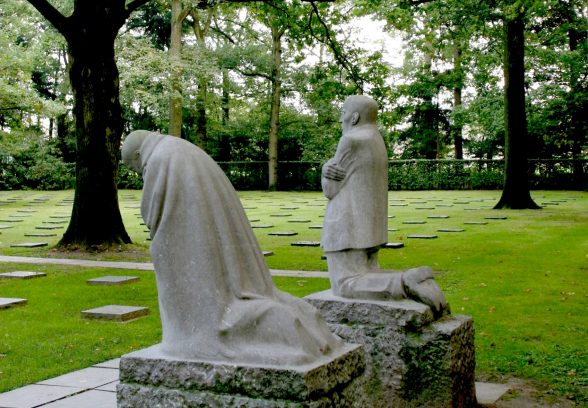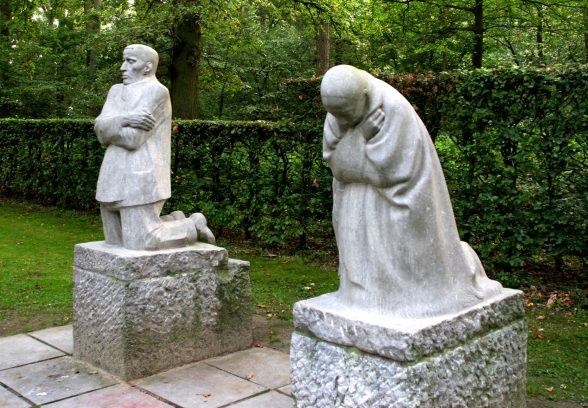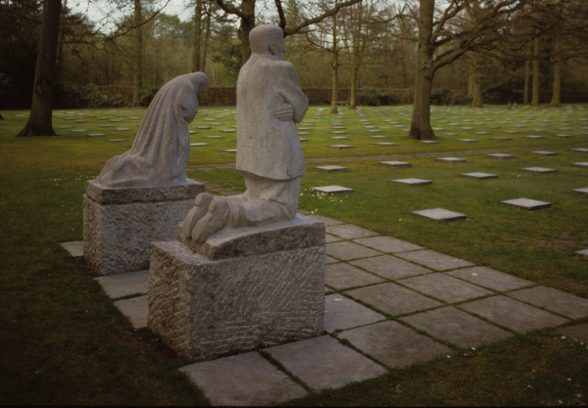This website uses cookies
This website uses cookies to enable it to function properly and to analyse how the website is used. Please click 'Close' to accept and continue using the website.






Belgium: Vladslo Deutsche Soldatenfriedhof, German Military Cemetery
Architect: Robert Tischler
Owners: Volksbund Deutsche Kriegsgräberfürsorge
Location: near Diksmuide, Belgium
Vladslo Deutsche Soldatenfriedhof: German Military Cemetery was one of the three enlarged collecting cemeteries to which bodies exhumed from many smaller cemeteries in Belgium were moved in 1956. It now contains the remains of 25,664 German war dead.
The red brick lodge building was designed by Robert Tischler at the end of his long career as chief architect to the Volksbund Deutsche Kriegsgräberfürsorge. Vladslo Cemetery is, however, most important as the home of one of the most poignant and universally significant works of art of the 20th century. At the far side of the cemetery, beyond the vast carpet of flat granite gravestones – each marking the resting place of eight men – are two bowed, kneeling granite figures on plinths, one male, one female. These are the Trauernden Elternpaares – the Mourning Parents – sculpted by Käthe Kollwitz (1867-1945). They were originally placed in the German cemetery at Eessen-Roggeveld (since removed) some three miles to the south-east where they overlooked the grave of her younger son Peter, killed near Diksmuide in October 1914 at the age of 18. They, and he, were moved to Vladslo in 1956. The figures are abstracted and formalised portraits of Kollwitz and her husband Karl. She began to plan a memorial to her beloved son soon after his death and soon arrived at the concept of grieving parents. But nothing could be done until 1925 when the Volksbund Deutsche Kriegsgräberfürsorge began to organise the war cemeteries in Belgium. She began work on the figures that year. The following year, 1926, she and her husband visited Roggevelde. In a letter, she described how
“the cemetery is close to the highway… The entrance is nothing but an opening in the hedge that surrounds the entire field. It was blocked by barbed wire… What an impression: cross upon cross. Some of the graves originally had largish wooden crosses which the weather had ruined, and these had fallen over; but on most of the graves there were low, yellow wooden crosses. A small metal plaque in the centre gives the name and number. So we found our grave… We cut three tiny roses from a flowering wild briar and placed them on the ground beside the cross. All that is left of him lies there in a row-grave… We considered where my figures might be placed… What we both thought best was to have the figures just across from the entrance, along the hedge… Then the kneeling figures would have the whole cemetery before them… Fortunately no decorative figures have been placed in the cemetery, none at all. The general effect is of simple planes and solitude. Except for two small farms there is no house in the vicinity; it is situated in the midst of fields. Everything is quiet, but the larks sing gladly”.
Kollwitz modelled the figures at half life-size and they were then carved in Belgian granite by the sculptors August Rhades and Fritz Diederich. They were completed in 1931, when they were exhibited at the National Gallery in Berlin, and were installed at Roggeveld the following year. In her diary for 23rd July 1932, she described how, “The British and Belgian cemeteries seem brighter, in a certain sense more cheerful and cosy, more familiar than the German cemeteries. I prefer the German ones. The war was not a pleasant affair; it isn’t seemly to prettify with flowers the mass deaths of all these young men. A war cemetery ought to be sombre…” [Hans Kollwitz, ed., The Diary and Letters of Kaethe Kollwitz, trans R. & C. Winston (Evanston, 1988)]
As it happened, Lutyens’s Memorial to the Missing of the Somme at Thiepval was unveiled – with rather more fanfare – only week or so later. Both, surely, are among the greatest of the artistic responses to the European catastrophe of the Great War – one vast and sublime, the other small and intimate – and Kollwitz’s Mourning Parents rank along with Jagger’s figures on the Artillery Memorial in London and Rayner Hoff’s work at the Anzac Memorial in Sydney as the finest examples of 20th century war memorial sculpture.
A year later, Hitler became Chancellor of Germany. The art of this heroic woman and artist, a socialist and pacifist, was unacceptable to the Nazi regime and she soon feared that “they would remove my figures from the cemetery in Belgium”. In 1936 her work was removed from art galleries, she was interrogated by the Gestapo and threatened with being sent to a concentration camp; the following year she enjoyed the distinction of being included in the Degenerate Art exhibition in Munich. Kollwitz died in 1945. In 1993-95, a cast of her Pietà was installed in the former national war memorial in Berlin, the old Guard House in the Unter den Linden by Schinkel, to replace the eternal flame when it was made into a memorial to the victims of war and totalitarianism. But perhaps it is not that work in Berlin but the grieving figures now kneeling in the cemetery at Vladslo that speak the more powerfully of the desolation created by war.
Gavin Stamp
Either enter the name of a place or memorial or choose from the drop down list. The list groups memorials in London and then by country

Become a C20 member today and help save our modern design heritage.